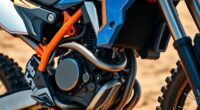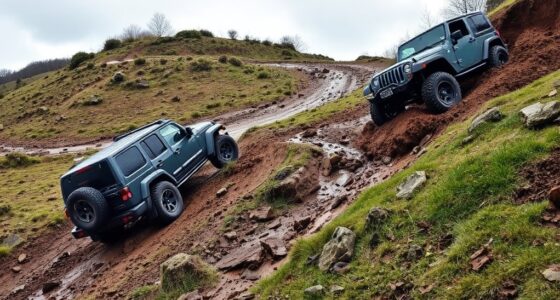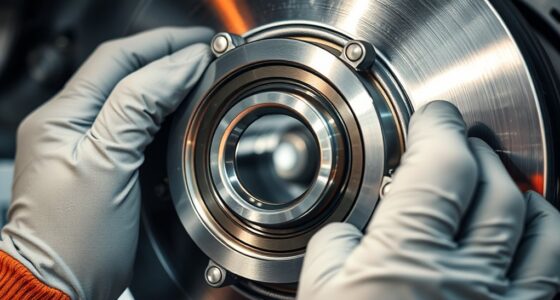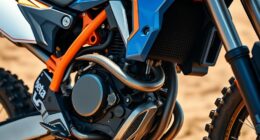Can-Am’s anti-lag and torque assist systems work together to give you instant engine response and smooth acceleration. The anti-lag keeps your turbo spooled for quick power delivery, while torque assist adds extra torque during acceleration, reducing lag and improving control. These systems guarantee your vehicle reacts immediately to your throttle, even in demanding conditions. Want to discover how these features can boost your ride? Keep going to find out more.
Key Takeaways
- Can-Am’s anti-lag system reduces turbo lag for rapid throttle response and smoother power delivery.
- Torque assist provides extra torque during acceleration, enhancing performance and reducing lag.
- The systems work together to maintain consistent turbo pressure and immediate engine response.
- Real-time engine monitoring adjusts boost levels for optimal performance in demanding terrains.
- Overall, these features deliver quick, predictable acceleration and improved vehicle control for riders.

Have you ever wondered how Can-Am vehicles deliver such rapid acceleration and smooth power delivery? The secret lies in their advanced anti-lag and torque assist systems, which are designed to maximize engine performance and enhance rider experience. When you hit the throttle, these systems work behind the scenes to maximize power output without the typical lag you’d expect from turbocharged engines. This is achieved through precise control of the turbo boost, ensuring it remains at ideal levels for instant response and maximum efficiency. As a rider, you’ll notice that the engine responds immediately to your inputs, providing a seamless acceleration that feels both powerful and predictable.
The turbo boost system in Can-Am vehicles is engineered to maintain consistent pressure, even during rapid throttle changes. This means you get instant throttle response, allowing you to accelerate quickly without delay. The turbo charger spools up faster because the anti-lag system keeps the exhaust gases flowing smoothly through the turbine, preventing the usual lag caused by turbo spool-up times. As a result, you experience a more direct connection between your throttle input and the engine’s power output. This setup not only enhances performance but also improves overall rideability, especially in demanding terrains where quick, precise responses are vital.
Engine response is further refined through the integration of the anti-lag system, which constantly monitors engine parameters and adjusts boost levels in real-time. When you’re riding at high speeds or maneuvering technical sections, this system ensures that power delivery remains consistent and predictable. It reduces the delay between your throttle input and the engine’s reaction, making your ride smoother and more controlled. The torque assist feature complements this by providing additional torque during acceleration, reducing lag and making the change from idle to full throttle seamless. This synergy between turbo boost, engine response, and torque assist not only delivers exhilarating acceleration but also maintains stability and control, even at high speeds.
In essence, Can-Am’s anti-lag and torque assist systems give you a competitive edge, whether you’re racing or tackling tough off-road trails. They work together to guarantee that your vehicle responds instantly to your commands, providing a level of power delivery that’s both aggressive and refined. With these cutting-edge technologies, you can push your vehicle to its limits with confidence, knowing that the engine’s response is optimized for maximum performance. This combination of turbo boost control, rapid engine response, and performance enhancement makes every ride more exhilarating, giving you the confidence to conquer any terrain with precision and power.
Frequently Asked Questions
How Do Anti-Lag Systems Affect Engine Longevity?
Anti-lag systems can increase engine wear because they keep the turbo spinning at high speeds, which puts extra stress on engine components. This often leads to more frequent maintenance because parts may wear out faster. If you use anti-lag extensively, expect to check your engine more often and perform repairs sooner. While they boost performance, they can also shorten your engine’s lifespan if not properly maintained.
Are Torque Assist Systems Legal in Competitive Racing?
Torque assist systems are generally not legal in competitive racing because they often conflict with racing regulations that restrict electronic aids. You need to verify the specific technology legality rules of your racing series, as some organizations ban or limit such systems to ensure fair competition. Using torque assist systems can give you an unfair advantage and might lead to disqualification if they’re deemed illegal under the current racing regulations.
Can Anti-Lag Systems Be Activated Manually?
Yes, you can manually activate anti-lag systems, giving you user control over the feature. Most systems are designed with a manual activation option that allows you to engage or disengage the anti-lag at will, often through a switch or button on your vehicle. This control lets you optimize performance during racing or riding, but always guarantee you’re following local rules and regulations regarding system use.
What Maintenance Is Required for These Systems?
Ever wonder if your anti-lag or torque assist systems need extra care? Regular maintenance involves checking fuel efficiency and noise levels, which can indicate system health. You should inspect and clean sensors, ensure proper fuel delivery, and update software if needed. Keeping these systems in good shape minimizes noise and maximizes performance, helping you avoid costly repairs. Do you routinely monitor these signs to keep your vehicle running smoothly?
Do All Can-Am Models Include These Technologies?
Not all Can-Am models include anti-lag and torque assist systems. These technologies are typically found on higher-performance models and may be affected by aftermarket modifications, which could impact emission regulations. If you’re considering a model with these features, check the specific model’s specs. Keep in mind that modifying these systems might void warranties or violate emission laws, so always verify compatibility before making changes.
Conclusion
So, next time you hit the throttle, remember that Can-Am’s anti-lag and torque assist systems aren’t just tech—they’re the secret behind smoother, more responsive rides. It’s funny how a little innovation can turn a simple ride into an adrenaline-fueled adventure. Whether you’re pushing limits or just cruising, those systems work quietly behind the scenes, making every moment more exhilarating. Who knew that a touch of smart engineering could change your entire ride?








